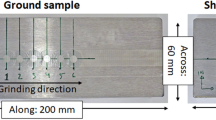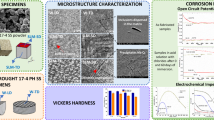Abstract
Surface of the casted pieces made of aluminium piston alloys was treated by a plasma jet produced by the magnetoplasma compressor, with an aim to improve their exploitation properties. Fast piston surface heating and melting, physical and chemical changes within the surface layer and the melted layer recrystallization in the fast cooling conditions are the basic characteristics of the interaction between the plasma from the magnetoplasma compressor and piston alloys. The major changes are conducted in the surface layer inducing hardness increment and piston resistance. Micro hardness of plasma treated surface is 750 to 883 HV0.2, in comparison with 90 to 130 HV0.2 in initial stage. The X-ray structure analysis of samples in cast state before and after plasma treatment shows existence of modified zones in hardened layer with phase transformations. In plasma flow treated surface at least two new phases are registered, with redistribution of already existing phases. These intermetallic phases contributed to treated surface hardness increasing. These observations show that quasi-stationary compressed plasma flow treatment of sample surface influences remarkably modification and improvement of surface properties.
Similar content being viewed by others
References
Dojcinovic, I., Astaslynski, V., Kuraica, M., and Puric, J., Appl. Phys. Serbian, 2002, p. 225.
Kuraica, M., Astaslynski, V., Dojcinovic, I., and Puric, J., Appl. Phys. Serbian, 2002, p. 221.
Acimovic-Pavlovic, Z., Kuraica, M., Dojcinovic, I., et al., Aluminum-Silicon Alloy Castings Surface Treatment, Belgrade: Faculty of Technology and Metallurgy, 2005.
Morozov, A.I., Sov. J. Plasma Phys., 1990, vol. 16, p. 69.
Kovrov, P.E. and Shubin, A.P., Sci. Technic., 1974, p. 78.
Dojcinovic, I., Gemisic, M., Obradovic, B., and Kuraica, M., J. Appl. Spectroscophy, 2001, vol. 68, p. 824.
Ananin, S.I., at al., Sov. J. Plasma Phys., 1990, vol. 16, p. 102.
Klos, R., Aluminium-Güsslegierungen, Verlag Moderne Ind., 1995.
Mondolfo, L.F., Aluminium Alloys Structures and Properties, London-Boston: Butter Worths, 1976, pp. 295, 368, 566, 672, 759.
Author information
Authors and Affiliations
Corresponding author
Additional information
The article is published in the original.
Rights and permissions
About this article
Cite this article
Ac’imovic’-Pavlovic’, Z., Raic’, K.T. & Belic’, I. Modification of piston surfaces by compressed plasma flow. Prot Met Phys Chem Surf 47, 797–802 (2011). https://doi.org/10.1134/S2070205111060190
Received:
Published:
Issue Date:
DOI: https://doi.org/10.1134/S2070205111060190




